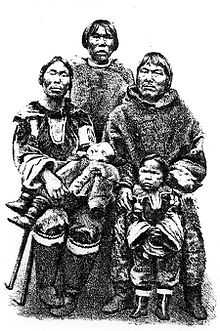Abraham Ulrikab

Abraham Ulrikab (January 29, 1845[1] - January 13, 1881) was an Inuk from Hebron, Labrador, in the present day province of Newfoundland and Labrador, Canada, who – along with his family and four other Inuit – agreed to become the latest attraction in the ethnographical shows organized by Carl Hagenbeck, owner of the Tierpark Hagenbeck, a zoo in Hamburg, Germany.
The eight Inuit were from two families. Their approximate ages upon arrival in Europe were as follows:
- The Christian family
- Abraham, 35,
- Ulrike, 24, his wife
- Sara, 4, daughter
- Maria, infant daughter, 10 months
- Tobias, 20, a young unmarried man.
- The non-Christian family
- Terrianiak, about 40, father
- Paingo, as old as 50, wife
- Noggasak, their teenage daughter about 15.
On August 26, 1880, all eight Inuit boarded the schooner Eisbär (which means "polar bear" in German) and headed to Europe. They arrived in Hamburg on September 24, 1880. Their show at the Tierpark Hagenbeck opened on October 2. On October 15, the group was moved to Berlin where they were exhibited at the Berlin zoo until November 14. They then traveled to Prague followed by Frankfurt and Darmstadt. Here, Noggasak died suddenly on December 14. The group moved on to Crefeld where Paingo died on December 27. It wasn't until little Sara showed symptoms that the doctors were finally able to diagnose the cause of death of the two women: smallpox. It is with a broken heart that Abraham and Ulrike had to entrust Sara to the hospital in Crefeld when the group had to depart for Paris. Sara died on December 31 as her parents arrived in Paris. The five survivors were vaccinated against smallpox on January 1, 1881. Unfortunately, it was too late. The group was exhibited at the Jardin d'Acclimation in the Bois de Boulogne for about a week. Then, on January 9, 1881, they were admitted to the St. Louis Hospital where they all died within the next week. Maria died on January 10. Terrianniak on January 11. Tobias and Abraham died on January 13, and Ulrike, the last to live, died January 16, 1881.
Norwegian Johan Adrian Jacobsen, who had recruited them, had omitted to have them vaccinated against smallpox, even though it was a mandatory requirement as per German law. In his own diary, he admits that he had totally forgotten about it.
Abraham was literate, an accomplished violin player and a devout Christian. He became the natural leader of the eight and had agreed to go to Europe to earn the money that would allow him to repay a debt of £10 to the Moravian mission in Hebron. He was also curious to visit Europe and was looking forward to see some of the moravian missionaries when they were posted in Labrador.
Abraham kept a diary written in his native Inuktitut; it was among his possessions that were sent back to the Moravian mission in Hebron after his death. The diary tells us that within weeks of arriving in Europe, the families realized they had made a mistake in coming and they longed to return to Labrador.
Up to now, the locations of the Inuit's graves were unknown. In fall 2014, the publication of the book In the Footsteps of Abraham Ulrikab revealed that the remains of Abraham, of his wife Ulrike, of their daughter Maria, of young Tobias and of Terrianiak were located in Paris. The skullcap of Paingo, which had been taken by Jacobsen during her autopsy in Crefeld and brought to Paris, was also found in Paris. Lastly, the skull of Sara was located in Berlin.
The authorities and the people of Nunatsiavut have started their reflection as to whether or not the remains should be brought back to Canada.[2][3]
Books published on Abraham Ulrikab
| Year | Title | ISBN |
|---|---|---|
| 2005 | Blohm, Hans, Alootook Ipellie and Hartmut Lutz. The Diary of Abraham Ulrikab. Ottawa: University of Ottawa Press | 978-0-7766-0602-6 |
| 2007 | Lutz, Hartmut, Kathrin Grollmuß, Hans Blohm and Alootook Ipellie. Abraham Ulrikab im Zoo: Tagebuch eines Inuk 1880/81. Wesee (Germany): vdL:Verlag. German translation of The Diary of Abraham Ulrikab. | 978-3-9263-0810-8 |
| 2014 | Jacobsen, Johan Adrian. Voyage with the Labrador Eskimos, 1880-1881. Gatineau (Quebec): Polar Horizons. (English translation by Lutz, Hartmut of Johan Adrian Jacobsen's diary) | 978-0-9936740-5-1 (softcover) 978-0-9936740-1-3 (pdf) |
| 2014 | Jacobsen, Johan Adrian. Voyage avec les Eskimos du Labrador, 1880-1881. Gatineau (Quebec): Horizons Polaires. (French translation by Jacqueline Thun of Johan Adrian Jacobsen's diary). | 978-0-9936740-4-4 (softcover) 978-0-9936740-0-6 (pdf) |
| 2014 | Rivet, France. In the Footsteps of Abraham Ulrikab: The events of 1880-1881. Gatineau (Quebec): Polar Horizons. | 978-0-9936740-6-8 (softcover) 978-0-9936740-3-7 (pdf) |
| 2014 | Rivet, France. Sur les traces d'Abraham Ulrikab : Les événements de 1880-1881. Gatineau (Quebec): Horizons Polaires. | 978-0-9936740-7-5 (softcover) 978-0-9936740-2-0 (pdf) (in French) |
See also
- List of people of Newfoundland and Labrador
References and notes
- ↑ Rivet, France. "In the Footsteps of Abraham Ulrikab: The events of 1880-1881". Gatineau: Polar Horizons. 2014. p. 29
- ↑ Rivet, France. "Longed to come home: Killed by smallpox in 1881, the remains of five Labrador Inuit are uncovered in Paris". Labrador Life, Fall 2014. pp. 12-14
- ↑ Montague, Derek. "Remains of Labrador Inuit found". The Labradorian, November 27, 2014
External links
- Nunatsiaq News Item
- Heritage Newfoundland article on native Inuit of Labrador
- Heritage Newfoundland article on the Moravian Mission in Labrador
- The Diary of Abraham Ulrikab ISBN 0-7766-0602-6 University of Ottawa Press
- Abraham's Diary, a two-hour documentary by Battery Radio, aired on CBC Radio One
- In the Footsteps of Abraham Ulrikab Research project
- Remains of Labrador Inuit found
|